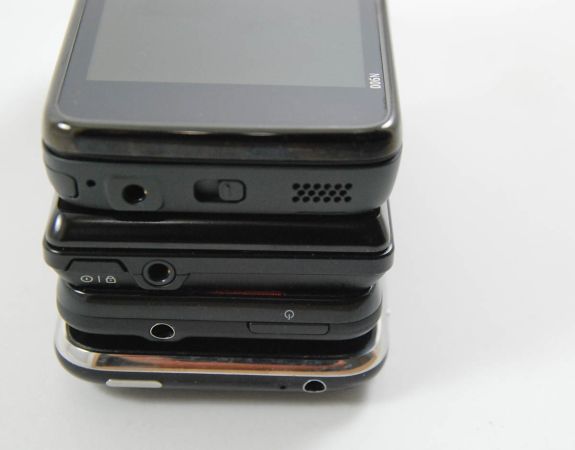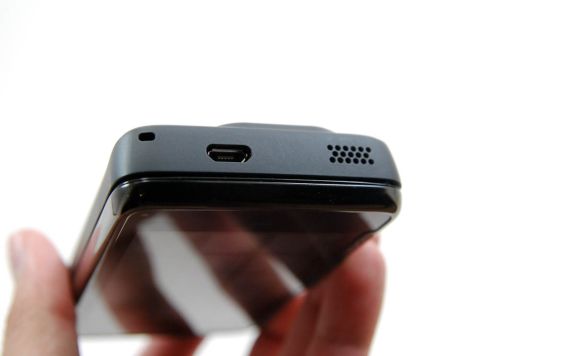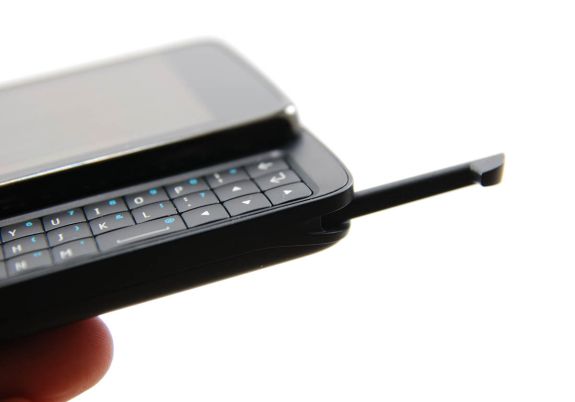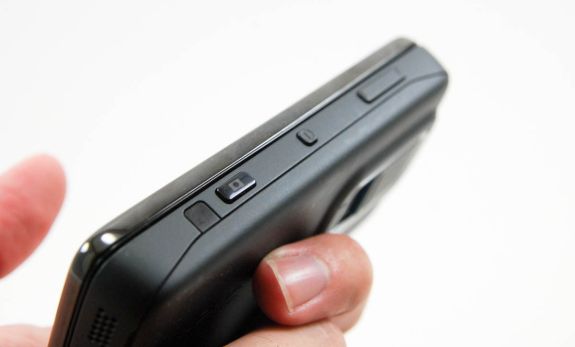Two OMAP 3430 Phones: Nokia N900 and Motorola Droid
by Brian Klug on June 10, 2010 9:29 PM EST- Posted in
- Smartphones
- N900
- Maemo
- Motorola Droid
- Droid
- MeeGo
- Android
- Mobile
N900 - A tank
Nokia has a reputation for building solid, nearly indestructible phones, and the N900 is no exception. Getting your hands on one, it's immediately obvious that the N900 takes nods from its ancestry: the N810, N800, and N770. The N900 obviously builds on the relatively tall and wide form tablet form factor heritage of those devices, squeezing it down into a pocketable form factor. That's clearly been done by trading the wide, tall, but thin internet tablet form factor from the N8xx and N770 for a thicker but smaller footprint device profile. It's obvious this is an internet tablet scaled down; part smartphone, part internet tablet. Compared to the Motorola Droid and HTC Incredible, it’s an unabashedly thick phone; this is a serious piece of hardware that doesn’t make any design compromises just for the sake of staying slim.
I already showed one photo illustrating the thickness against a few other smartphones, but here's a different angle just to drive home that point - the N900 is beefy.
The N900 has a number of signature Nokia quirks that you'll be familiar with if you've used Nokia devices, but might strike others as a bit odd. First of all, on the top of the N900 is where the microUSB port is located, and a speakerphone outlet.
On the bottom, you've got the spring activated standby/resume switch and 1/8" 3.5 mm headphone jack, along with a second speakerphone outlet and the end where the stylus is extracted. For me at least, putting the headset jack at the bottom is a bit confusing, as you get used to holding it this way (and considering it the top, since power is there) only to become disoriented when it's time to answer a call. I mean, look at the USB cable coming awkwardly out of the top. It just doesn't seem natural!
It's an aesthetic criticism that's hardly a major issue, but it's another small quirk that really drives home the point that this is an internet tablet in smartphone skin.
On the left side of the N900 is the region the stylus sits in for the resistive touch screen.
Finally, on the longer side opposite the stylus is the two position camera button, the power button (for really turning the device on or off), and the volume rocker.
















68 Comments
View All Comments
Wadzii22 - Friday, June 11, 2010 - link
Out of curiosity I ran linpack and Benchmark pi on my droid that's oc'd to 1ghzmy benchmark pi score was 1280 and linpack gives me 17.24 mflops
strikeback03 - Friday, June 11, 2010 - link
Did you run them stock? As those numbers seem to be a ~4x improvement over what is shown here, which seems odd given the ~2x increase in clockspeed.Wadzii22 - Wednesday, June 16, 2010 - link
with the phone completely stock my scores were basically the same as whats in the original article.jamyryals - Friday, June 11, 2010 - link
Please continue this type of in depth comparison with current and future hardware. PC hardware is all well and good, but it's all so fast now the mobile space is a much more interesting battle. Not to mention with how fast things are evolving there is the opportunity for a lot of content.Ratman6161 - Friday, June 11, 2010 - link
For eample, my droid purchased in early April came out of the box running at 600 MHz (though now it actually runs at up to 900 Mhz). My wife got hers in early June and hers is 600 MHz too and also came out of the box with Android 2.1 already on it.Wadzii22 - Friday, June 11, 2010 - link
For whatever reason, setcpu always sees a stock droid's max at 600, but they do run at 550. I just got a new one yesterday after bricking my old droid, it showed the same thing.CharonPDX - Friday, June 11, 2010 - link
Nokia was the originator of the "sell unsubsidized smartphones direct" model, years before Apple or Google. You could get a Nokia N80 at CompUSA completely unlocked for $800 in 2006, a year before the unsubsidized iPhone.Stas - Friday, June 11, 2010 - link
0.1 build with fixed WiFi and maps.LinPack - 12.2 (twelve point two)MFLOPS
Engadget.com loads in 20 sec (default browser)
'nuff said.
Stas - Friday, June 11, 2010 - link
forgot to mention. the CPU is at 800Mhz. I've had it up at 900Mhz with bare Android build (leaked 2.2) and the performance seems no different, but no numbers, sorry.milli - Saturday, June 12, 2010 - link
That's pretty wrong what you're saying there.Qualcomm didn't even license the A8 (nor will they ever).
What they did license is the ARMv7 instruction set (and that's a huge difference). With that they made a custom implementation of the ARMv7 architecture. (BTW Qualcomm already stated in 2005 that they're an architectural licensee for ARM’s ARMv7 instruction set)
There are many differences between Scorpion and A8.
I'll quote from a certain article since i can't say it better:
'Although Scorpion and Cortex-A8 have many similarities, based on the information released by Qualcomm, the two cores differ in a number of interesting ways. For example, while the Scorpion and Cortex-A8 NEON implementations execute the same SIMD-style instructions, Scorpion’s implementation can process128 bits of data in parallel, compared to 64 bits on Cortex-A8. Half of Scorpion’s SIMD data path can be shut down to conserve power. Scorpion’s pipeline is deeper: It has a 13-stage load/store pipeline and two integer pipelines—one of which is 10 stages and can perform simple arithmetic operations (such as adds and subtracts) while the other is 12 stages and can perform both simple and more complex arithmetic, like MACs. Scorpion also has a 23-stage floating-point/SIMD pipeline, and unlike on Cortex-A8, VFPv3 operations are pipelined. Scorpion uses a number of other microarchitectural tweaks that are intended to either boost speed or reduce power consumption. (Scorpion’s architects previously designed low-power, high-performance processors for IBM.) The core supports multiple clock and voltage domains to enable additional power savings."
"Qualcomm claims that Scorpion will have power consumption of roughly 200 mW at 600 MHz (this figure includes leakage current, though its contribution is typically minimal in low-power processes). In comparison, ARM reports on its website that a Cortex-A8 in a 65 nm LP process consumes .59 mW/MHz (excluding leakage), which translates into about 350 mW at 600 MHz."
With that said, i don't understand where the misconception about the Scorpion being an A8 started. Even Qualcomm states clearly on their own website that Scorpion is not licensed from ARM. They also state that they invested hundred of millions in creating their own core based on the ARMv7 instruction set.
I hope now all the staff from Anand will stop saying that there's an A8 inside of Snapdragon. Or maybe you should even clarify that with a small article.